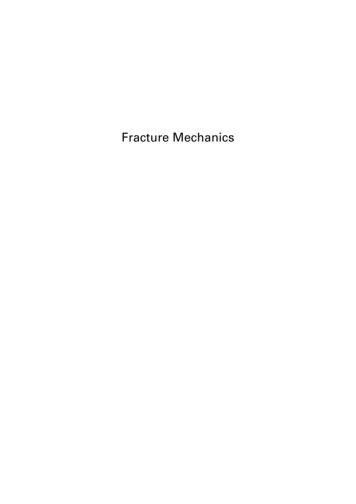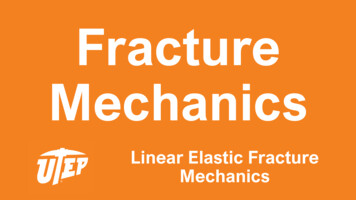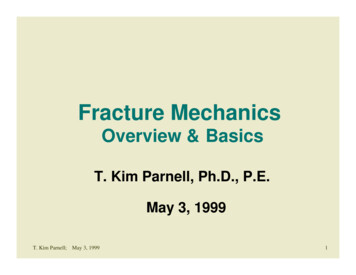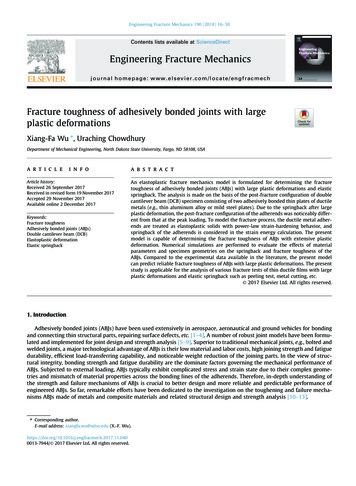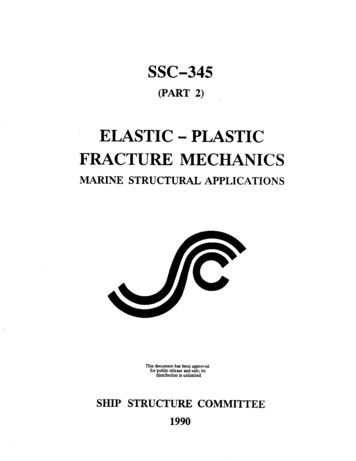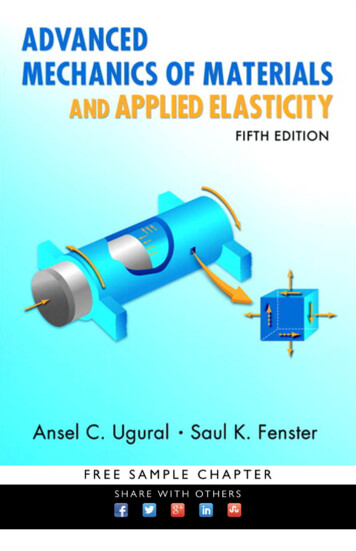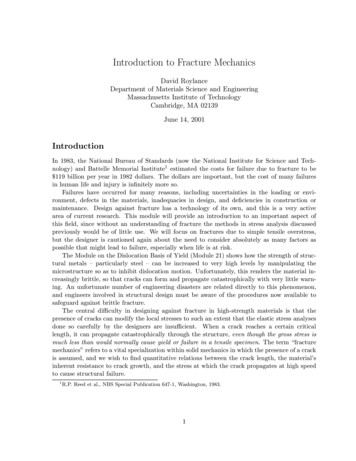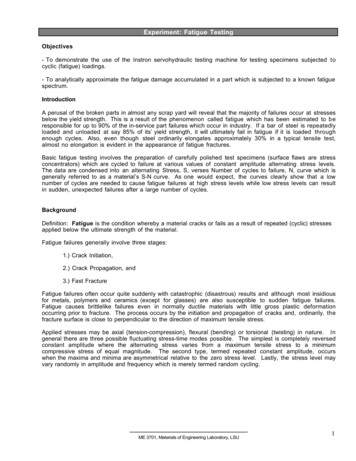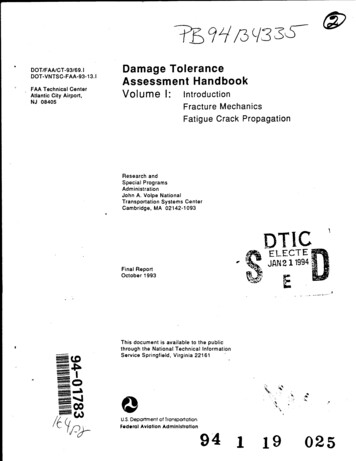
Transcription
Damage ToleranceAssessment HandbookVolume I: IntroductionDOT/FAA/CT-93/69. IDOT-VNTSC-FAA-93-13. I,FAA Technical CenterAtlantic City Airport,NJ 08405Fracture MechanicsFatigue Crack PropagationResearch andSpecial ProgramsAdministrationJohn A. Volpe NationalTransportation Systems CenterCambridge, MA 02142-1 0938Final ReportOctober 1993IThis document is available to the publicthrough the National Technical InformationService Springfield, Virginia 22161.'U.S. Department of TransportationFederal Avlation Adrnlnlstratlon9 4 1 19025
i
1REPORT DOCUMENTATION PAGEFormAp rovedOMB No. d204-0188P@lic reporting burf o r t h i s c o l l e c t i o n of i n f o m e t i o n i s e s t i m t e d t o average 1 hour per r e a s , ineldim theti for r w i e u i n g instructions searchiexistfdata soUrces, gathering a@ m i n t a i n i n g thet a needed, ndc w l e t i m ard revieuina the coflectioni n f o d i m . Send conrnents r w a r d i m t h i s burden estimate or YIY other21. AGENCY USE OtiLY (Leave .blank)II2. REPORT DATEOctober 19933. REPORT TYPE AND DATES COVEREDAND SUETITLEDamage Tolerance Assessment HandbookVolume I: IntroductionFracture MechanicsFatigue Crack Propagation4 . TITLEJune 1990I 5.-Dec. 1992FLINDING NWBERSFh3H2/A31286. AUTHOR(S)7. PERFORMING O U G M l U T I O L I NAME(S) AND ADDRESS(ES1U.S. Department o f Transportation8. PERFORMING ORCWIUTlWREPOUT NWBERResearch and Special Progrems AdninistrationVolpe National Transportation S y s t e m s CenterKcndell Square, C d r i d g e , M A 02162DOT-VNTSC-FAA-93-13.19. SPOUSORING/IK)WITORING AGENCY NAME(S) AND ADDRESSCES)10. SPOUSORIYG/IIIWIITORINGAGENCY REPORT NUMBERFederal Aviation AdministrationTechnical CenterAtlantic City AirportNJ 08405DOT/FAA/CT-93/69.111. SUPPLEMENTARY NOTES121. DlSTRlBUTIOY/AVAILABILITY STATEMENT12b. DISTRIBUTIOY COO This document is available to the public through the NationalTechnical Infoqnation Service, Springfield, VA 2216113. ABSTRACT (Haxinun 200 words)This "Damage Tolerance Assessment Handbook" consists of two volumes:Volume I introduces the damage tolerance concept with a historical perspectivefollowed by the fundamentals of fracture mechanics and fatigue crack propagation.Various fracture criteria and crack growth rules are studied.Volume I1 treats exclusively the subject of damage tolerance evaluation of airframes15. NWBER OF PAGES14. SUBJECT TERMSDmmge Tolerance, Fracture Mechanics, Crack I n i t i a t i o n , Fracture Toughness, StressI n t e n s i t y Factor, Residual Strength, Crack Propagation, Fatigue, Inspection.I17. SECURITY CLASSIFICATIWOF REPORTUnclassified18. SECURITY CLASSIFICATIOLIOF THIS PAGEUnclassifiedI 16.1119. SECURITY CLASSIFIUTIOWOF ABSTRACTPRICE CODE20. LlWlTATlOY OF ABSTRACTUnclass if iedStar FormP r e s 5 i L bv298-102(Rev.-Std. t 3 P h
PREFACEThe preparation of this Handbook has required the cooperation of numerous individuals from theU.S. Government, universities, and industry. It is the outcome of one of the research programson the Structural Integrity of Aging Aircraft supported by the Federal Aviation AdministrationTechnical Center and performed at the Volpe Center of the Department of Transportation.The contributions fiom the Federal Aviation Administration, the FAA Technical Center, theDepartment of Defense, and the staff of the Volpe Center are greatly acknowledged.Please forward all comments and suggestions to :U.S. Department of TransportationOffice of Systems Engineering, DTS-74Volpe National Transportation Systems CenterCambridge, MA 02 142I AccesionNTISDTlCForCRA&ITABAvail a n d l o r.111I
M E T R I U E N G L I S H CONVERSION FACTORSENGLISH T O METRICMETRIC T O ENGLISHLENGTH (APPROXIMATE)1 inch (in.)1 foot (ft)1 yard (yd)1 mile (mi)L E N G T H (APPROXIMATE) 2.5 centimeters (cm) 30 Centimeters (cm) 0 9 meter (m) 1.6kilometers (km)A R E A (APPROXIMATE)1 square inch (sq in, in211 square foot (sq ft, ft2)1 square yard (sq yd. yd2)1 square mile (sq mi, mi211 acre 0 4 hectares (he)A R E A (APPROXIMATE)1 square centimeter (cm2) 0.16 square inch (sq in, in2)1 square meter (m2) 1.2 square yards (sq yd, yd2)1 square kilometer (knz) 0.4square mile (sq mi, mi2)1 hectare (he) 10,000square meters (m2) 2.5 acres 6.5square centimeters (cm2) 0 09 square meter (m2) 0.8 square meter (m2) 2.6square kilometers (km2) 4,000square meters (m2)MASS-WEIGHT-M A S S W E I G H T (APPROXIMATE)(APPROXIMATE)1 ounce ( 0 2 ) 28 grams (gr)1 pound (Ib) 45 kilogram (kg)1 short ton 2,000 pounds (Ib) 0 9 tonne (t)1 gram (gr) 0.036ounce (oz)1 kilogram (kg) 2.2 pounds (Ib)1 tonne(t) 1,000kilograms(kg) 1.1 shorttonsVOLUMEVOLUME*(APPROXIMATE)TEMPERATURE[ (x - 32)(5i9)I O F(APPROXIMATE) 0.03 fluid ounce (fl oz) 2.1 pints(pt) 1.06 quarts (qt) 0.26 gallon (gal) 36 cubic feet (tuft, f t 3 ) 1.3 cubic yards (cu yd, yd3)1 milliliter (ml)1 liter(1)1 liter (I)1 liter (I)1 cubic meter (m3)1 cubic meter (m3) 5 milliliters (ml) 15 milliliters (rnl) 30 milliliters (ml) 0 24 liter (I) o 47 liter (I) 0 96 liter (I) 3 8 liters (I) 0 03 cubic meter (m3) 0 76 cubic meter (m3)1 teaspoon (tsp)1 tablespoon (tbsp)1 fluid ounce (fl OZ)1 cup (c)i p i n t (pt)1 quart (qt)1 gallon (gal)1 cubic foot (cu ft,ft3)1 cubic yard (cu yd, yd3) 0.04inch (in) 0.4inch (in) 3.3 feet (ft) 1 .l yards (yd) 0.6 mile (mi)1 millimeter (mm)1 centimeter (cm)1 meter (m)1 meter (m)1 kilometer (km)TEMPERATURE (EXACT) 32 1 C x(EXACT)[(9/5)y y"COFQUICK INCH-CENTIMETER L E N G T H 1213151487III617182019910I2221232425.40QU ICK F A H RE NHEIT-CE LSI US TEMPERATURE CONVERSION-rooOFOCI40'-noI-30'4 140'158*IIIIIIIII40'50'60'70'80'90'176'For more e x a c and or other c o n v e r s i o n faCtors, see NBS Miscellaneous Publication 286,Units of Weights andMeasures Price 52.50 SDCatalog No C13 10286.iv194'I212'Ilooo
TABLE OF CONTENTSi1.INTRODUCTION . . . . . . . . . . . . . . . . . . . . . . . . . . . . . . . . . . . . . . . . . . . .1.11.1 Historical Perspective . . . . . . . . . . . . . . . . . . . . . . . . . . . . . . . . . . . . . .1.2 Results of Air Force Survey . . . . . . . . . . . . . . . . . . . . . . . . . . . . . . . .1.3 Comparison of Old and New Approaches . . . . . . . . . . . . . . . . . . . . . . .1-21-121-131.3.1 Fatigue Safe-Life Approach . . . . . . . . . . . . . . . . . . . . . . . . . . .1.3.2 Damage Tolerance Assessment (DTA) Approach . . . . . . . . . . . . .2.1-161-25FRACTURE MECHANICS . . . . . . . . . . . . . . . . . . . . . . . . . . . . . . . . . . . . .2-12.1 Stress Concentration. Fracture and Griffith Theory . . . . . . . . . . . . . . . . . .2-12.1.1Fracture Modes . . . . . . . . . . . . . . . . . . . . . . . . . . . . . . . . . . . .2-192.2 Extension of Linear Elastic Fracture Mechanics to Metals . . . . . . . . . . . .2-21Plastic Zone Size and the Mises-Hencky Yield Criterion . . . . . . .2-242.2.12.3 Fracture Toughness Testing . . . . . . . . . . . . . . . . . . . . . . . . . . . . . . . . . .2.3.12.3.22-26Thickness Effects . . . . . . . . . . . . . . . . . . . . . . . . . . . . . . . . . .Temperature Effects . . . . . . . . . . . . . . . . . . . . . . . . . . . . . . . . .2-332-372.4 Failure in the Presence of Large-Scale Yielding . . . . . . . . . . . . . . . . . . .2.4.1Resistance Curves . . . . . . . . . . . . . . . . . . . . . . . . . . . . . . . . . .2.4.1.12.4.2Graphical Construction of Thin-Section Strength Plots2-382-39.2-43The Net Section Failure Criterion . . . . . . . . . . . . . . . . . . . . . . .2-522.4.2.12-54Failure Mode Determination and the Feddersen Diagram2.4.3 Crack Opening Displacement . . . . . . . . . . . . . . . . . . . . . . . . . .2.4.4 J-Integral . . . . . . . . . . . . . . . . . . . . . . . . . . . . . . . . . . . . . . . . .2.4.5 Practical Developments . . . . . . . . . . . . . . . . . . . . . . . . . . . . . . .2.4.6 Strain Energy Density Criterion . . . . . . . . . . . . . . . . . . . . . . . . .2.4.7 Plastic Collapse Model . . . . . . . . . . . . . . . . . . . . . . . . . . . . . . . .2.5 Internal. Surface. and Comer Cracks . . . . . . . . . . . . . . . . . . . . . . . . . .2.6 Environmental Effects . . . . . . . . . . . . . . . . . . . . . . . . . . . . . . . . . . . .V2-562-572-582-612-642-662-67
TABLE OF CONTENTS (continued)3.3-1Energy-Based Theory of Crack Propagation .Empirical Crack Growth Rate Equations . . . . . . . . . . . . . . . . . . . . . . . . .Correlation with Material Properties .Crack Growth Life Estimates . . . . . . . . . . . . . . . . . . . . . . . . . . . . . . .3-13-33-123-32FATIGUE CRACK PROPAGATION3.13.23.33.43.4.1Quick Estimates with Crack Geometry Sums3.5 Interaction Effects and Retardation Models4.AIRFRAME DAMAGE TOLERANCE EVALUATION4.1 Damage Tolerance Requirements for Transports.3-373-384-1. . . . . . . . . . . . . . . . . . . 4-24.1.1 Basic Definitions . . . . . . . . . . . . . . . . . . . . . . . . . . . . . . . . . . . . 4-24.1.2 The Damage Tolerance Evaluation Process . . . . . . . . . . . . . . . . . . 4-2b4.1:2.14.1.2.24.1.2.3Preparation Phase . . . . . . . . . . . . . . . . . . . . . . . . . . . .Evaluation Phase . . . . . . . . . . . . . . . . . . . . . . . . . . . .Inspectability Considerations .4.2 Identification of Structural Elements and Evaluation Locations4.2.14.2.2.4-54-74-94-10Wing and Empennage . . . . . . . . . . . . . . . . . . . . . . . . . . . . . . .Fuselage . . . . . . . . . . . . . . . . . . . . . . . . . . . . . . . . . . . . . . . . .4-124-18.4-334.3 Load Path Arrangement4.3.1 Splices Parallel to the Major Stress Axis . . . . . . . . . . . . . . . . . .4.3.2 Stiffeners as Crack Stoppers . . . . . . . . . . . . . . . . . . . . . . . . . . .4.3.3 Splices Across the Major Load Axis .4.3.3.14.3.4 Repairs4-344-414-51Load Concentration and the Benefit of FastenerFlexibility . . . . . . . . . . . . . . . . . . . . . . . . . . . . . . . .4-54.4-654.4 Material Considerations . . . . . . . . . . . . . . . . . . . . . . . . . . . . . . . . . . .4.5 Type and Extent of Damage . . . . . . . . . . . . . . . . . . . . . . . . . . . . . . . .4.6 Analysis and Tests . . . . . . . . . . . . . . . . . . . . . . . . . . . . . . . . . . . . . . .vi4-694-734-86
TABLE OF CONTENTS (continued)4.6.1 Load Specification and Stress Analysis4.6.1.1Gust Load Factors (FAR 23.231 and FAR 25.341)4.6.2 Residual Strength Evaluation4.6.3 Crack Growth Life Evaluation4.6.3.14.6.3.24.6.3.2.2.General Considerations for NondestructiveInspection (NDI) Methodologies and theInspection Intervals [Reference 4-13] . . . . 4-125Time to First Inspection and Safe InspectionInterval . . . . . . . . . . . . . . . . . . . . . . . . . .4- 126Approximate Estimation of SpectrumTruncation Points . . . . . . . . . . . . . . . . . . . 4- 141APPENDIX A . SELECTED STRESS INTENSITY FACTOR FORMULAE.4-984-122Safe Flight Time After Discrete Source Damage . . . . . 4-129Time to Loss of Fail-Safety .4-131Verification of Crack Growth Life . . . . . . . . . . . . . . . 4-1354.6.3.5.1APPENDIX B. . . . 4-92Modified Safe Life Based on Crack Growth . . . . . . . . . 4-122Damage Tolerance Evaluation Requiring Inspection . . . 4-1254.6.3.2.14.6.3.34.6?3.44.6.3.5. . . . . . . . . . . . . . . . . . . 4-86.SELECTED RESISTANCE (R-CURVE) PLOTS FOR AIRCRAFTMATERIALS . . . . . . . . . . . . . . . . . . . . . . . . . . . . . . . . . . . . . . . .viiA-1B-1
LIST OF 121-131-141-151-161-171-182- 12-22- 32-42-52-62-72-82-9Photograph of tanker Schenectady . . . . . . . . . . . . . . . . . . . . . . . . . . . . . . . .Comet I aircraft. circa 1952 . . . . . . . . . . . . . . . . . . . . . . . . . . . . . . . . . . . .Probable Comet failure initiation site . . . . . . . . . . . . . . . . . . . . . . . . . . . . . .USAF Tactical Air Command F-11 1A circa 1969.(a) F-111 in flight . . . . . . . . . . . . . . . . . . . . . . . . . . . . . . . . . . . . . .(b) F.111. plan view showing probable failure initiation site . . . . . . . . .(c) Crack in left wing pivot forging of F-111 aircraft . . . . . . . . . . . . .An aircraft fuselage failure(a) General view. left side of forward fuselage . . . . . . . . . . . . . . . . . .(b) General view. right side of forward fuselage . . . . . . . . . . . . . . . . .Examples of distribution and magnitude of service cracking problems . . . . . .Crack initiatiodgrowth and failure mechanisms.(a) 1226 major crackinglfailure incidents . . . . . . . . . . . . . . . . . . . . .(b) 64 major crackinglfailure incidents . . . . . . . . . . . . . . . . . . . . . . .Cracking and failure origins . . . . . . . . . . . . . . . . . . . . . . . . . . . . . . . . . . .Results of a typical fatigue experiment . . . . . . . . . . . . . . . . . . . . . . . . . . .Effect of mean stress . . . . . . . . . . . . . . . . . . . . . . . . . . . . . . . . . . . . . . . .Modified Goodman diagram . . . . . . . . . . . . . . . . . . . . . . . . . . . . . . . . . . .Goodman diagram for 2024-T4 aluminum . . . . . . . . . . . . . . . . . . . . . . . . .How the Palmgren-Miner rule is applied . . . . . . . . . . . . . . . . . . . . . . . . . .Fatigue quality index . . . . . . . . . . . . . . . . . . . . . . . . . . . . . . . . . . . . . . . .Uncertainties addressed by safety factor . . . . . . . . . . . . . . . . . . . . . . . . . . .Crack growth in response to cyclic loads . . . . . . . . . . . . . . . . . . . . . . . . . .Schematic relationship of allowable stress versus crack length . . . . . . . . . . .Residual strength diagram . . . . . . . . . . . . . . . . . . . . . . . . . . . . . . . . . . . .Circular hole in a large plate . . . . . . . . . . . . . . . . . . . . . . . . . . . . . . . . . . .Elliptical hole in a large plate . . . . . . . . . . . . . . . . . . . . . . . . . . . . . . . . . . .Ene.rgy principles .(a) Slender rod . . . . . . . . . . . . . . . . . . . . . . . . . . . . . . . . . . . . . . . .(b) Uniformly stressed thin plate . . . . . . . . . . . . . . . . . . . . . . . . . . . .Energy principles for cracked plate .(a) Initial crack length 2a . . . . . . . . . . . . . . . . . . . . . . . . . . . . . . . . . .(b) Elongated crack length 2(a Aa) . . . . . . . . . . . . . . . . . . . . . . . . .Plate with a center crack . . . . . . . . . . . . . . . . . . . . . . . . . . . . . . . . . . . . .Stress components in Irwin’s analysis . . . . . . . . . . . . . . . . . . . . . . . . . . . .Stress intensity factor formulae for some common geometiies .(a) Plate with center crack under tension .(b) Plate with edge crack under tension .Fracture modes . . . . . . . . . . . . . . . . . . . . . . . . . . . . . . . . . . . . . . . . . . . .Plastic zone formation ahead of crack tip . . . . . . . . . . . . . . . . . . . . . . . . . -92-92-112-142-172-172-202-23
LIST OF ILLUSTRATIONS (continued)2-102-1 12-122-132-142-152-162-172-182-192-202-2 12-222-232-242-252-262-272-282-292-302-3 12-322-332-342-352-362-372-382-392-402-41Refined estimate of plastic zone formation ahead of crack tip . . . . . . . . . . . .Plastic zone approximations based on von Mises criterion . . . . . . . . . . . . . .The compact tension specimen . . . . . . . . . . . . . . . . . . . . . . . . . . . . . . . . .CTS stress intensity factor versus crack length . . . . . . . . . . . . . . . . . . . . . .CTS orientation . . . . . . . . . . . . . . . . . . . . . . . . . . . . . . . . . . . . . . . . . . .Load-displacement plot . . . . . . . . . . . . . . . . . . . . . . . . . . . . . . . . . . . . . .Thickness effect on fracture strength . . . . . . . . . . . . . . . . . . . . . . . . . . . . .Plane stress-plane strain transition.(a) Three-dimensional plastic zone shape . . . . . . . . . . . . . . . . . . . . .(b) Plastic volume versus thickness . . . . . . . . . . . . . . . . . . . . . . . . .Typical fracture surfaces . . . . . . . . . . . . . . . . . . . . . . . . . . . . . . . . . . . . .Lateral compression above and below the crack . . . . . . . . . . . . . . . . . . . . .Lateral buckling and tearing . . . . . . . . . . . . . . . . . . . . . . . . . . . . . . . . . . .Fracture toughness versus temperature . . . . . . . : . . . . . . . . . . . . . . . . . . . .Load versus crack extension for different thicknesses . . . . . . . . . . . . . . . . .Experimental determination of R-curve . . . . . . . . . . . . . . . . . . . . . . . . . . .Dependence of K , on crack length . . . . . . . . . . . . . . . . . . . . . . . . . . . . . . .KI and KR curves . . . . . . . . . . . . . . . . . . . . . . . . . . . . . . . . . . . . . . . . . . .KI and KR curves (logarithmic scale) .Overlay of KI and KR curves to determine critical crack length . . . . . . . . . . .R-Curve for 2024-T3 . . . . . . . . . . . . . . . . . . . . . . . . . . . . . . . . . . . . . . . .K applied versus crack length . . . . . . . . . . . . . . . . . . . . . . . . . . . . . . . . . .Use of critical K to determine critical crack length . . . . . . . . . . . . . . . . . . .Critical stress determinations with KI and KR curves . . . . . . . . . . . . . . . . . .K, and 0. vs . a for a 20-inch aluminum panel . . . . . . . . . . . . . . . . . . . . . .Effect of surroundings on energy absorption rate.(a) Isolated medium or long crack . . . . . . . . . . . . . . . . . . . . . . . . . . (b) Shortcrack . . . . . . . . . . . . . . . . . . . . . . . . . . . . . . . . . . . . . . .(c) One crack tip near edge of a panel . . . . . . . . . . . . . . . . . . . . . . .Net section failure criterion . . . . . . . . . . . . . . . . . . . . . . . . . . . . . . . . . . .Net section and R-curve strength curves . . . . . . . . . . . . . . . . . . . . . . . . . .Illustration of the width effect on thin sheet strength . . . . . . . . . . . . . . . . . .Construction of Feddersen diagram . . . . . . . . . . . . . . . . . . . . . . . . . . . . . .Typical examples of three-dimensional aspects of cracks.(a) Comer crack at a fastener hole . . . . . . . . . . . . . . . . . . . . . . . . . .(b) Axial crack in an oxygen cylinder . . . . . . . . : . . . . . . . . . . . . . . .(c) Through-crack at a fuselage frame comer detail . . . . . . . . . . . . . .Strain energy density criterion . . . . . . . . . . . . . . . . . . . . . . . . . . . . . . . . .Definition of critical strain energy density . . . . . . . . . . . . . . . . . . . . . . . . .Erdogan’s plastic zone model . . . . . . . . . . . . . . . . . . . . . . . . . . . . . . . . . 5
LIST OF ILLUSTRATIONS 3-103-1 13-123-133-144- 14-24-34-44-54- 64-74-84-94-10Geometries of surface and comer cracks.(a) Flaw shape parameter for surface flaws .(b) Flaw shape parameter for internal flaws .Stress intensity factors for surface and comer cracks . . . . . . . . . . . . . . . . . .Deep flaw magnification factor curves .Argument for relating fatigue crack growth rate to applied stress intensityfactor . . . . . . . . . . . . . . . . . . . . . . . . . . . . . . . . . . . . . . . . . . . . . . . . . . . .Effect of cyclic load range on crack growth in Ni-Mo-V alloy steel forreleased tension loading . . . . . . . . . . . . . . . . . . . . . . . . . . . . . . . . . . . . . . .Alternate definitions of stress cycle .Crack growth rate in 7475-T6 aluminum .Effect of stress ratio on 7075-T6 aluminum crack growth rate . . . . . . . . . . . .Summary plot of dddN versus AK for six aluminum alloys . . . . . . . . . . . . .Summary plot of dddN versus AK for various steel alloys . . . . . . . . . . . . . .Summary plot of dddN versus AK for five titanium alloys . . . . . . . . . . . . .7075-T6 aluminum (0.09 in . thick) crack growth rate properties .(a) Results for R 0 and R 0.2 . . . . . . . . . . . . . . . . . . . . . . . . . .(b) Results for R 0.33 and R 0.5 . . . . . . . . . . . . . . . . . . . . . . . .(c) Results for R 0.7 and R 0.8 .7075-T6 properties (0.2 in . thick) from a different test series . . . . . . . . . . . .2024T3 aluminum (0.09 in . thick) properties.(a) Results for R 0.1 and R 0.11 (different test series) . . . . . . . . .(b) Results for R 0.33 . . . . . . . . . . . . . . . . . . . . . . . . . . . . . . . . .(c) Results for R 0.5 .(d) Results for R 0.7 . . . . . . . . . . . . . . . . . . . . . . . . . . . . . . . . . .2014-T6 aluminum (0.25 in . thick) properties at R 0 . . . . . . . . . . . . . . . .2014-T6 aluminum properties for different thickness and stress ratio . . . . . . .Effects of thickness and environment. .(a) Effect of thickness on FCP behaviour of 7475T651 machinedfrom 1-inch plate and tested in dry air .(b) A comparison between the FCP rates in dry air and 3.5% NaClsolution for aluminum alloys .Structure of requirements and guidelines .Structural classification of an airframe .Wing box configuration and function .:. . . . . . . . . . . . . .Stress in a wing box .Simplified fuselage model . . . . . . . . . . . . . . . . . . . . . . . . . . . . . . . . . . . .Stress in a fuselage shell . . . . . . . . . . . . . . . . . . . . . . . . . . . . . . . . . . . . .Framebending . . . . . . . . . . . . . . . . . . . . . . . . . . . . . . . . . . . . . . . . . . . .Floor cross-beam function . . . . . . . . . . . . . . . . . . . . . . . . . . . . . . . . . . . . .Local bending of fuselage at floor . . . . . . . . . . . . . . . . . . . . . . . . . . . . . . .Typical bulkhead arrangement . . . . . . . . . . . . . . . . . . . . . . . . . . . . . . . . 4-154-164-194-214-234-234-244-26
LIST OF ILLUSTRATIONS (continued)I4-1 14-124-134-144-154-164-174-184-194-204-2 14-224-234-244-25'4-264-274-284-294-304-3 14-324-334-34I4-354-364-374-384-394-404-41Bending stress distributions in a flat circular panel loaded by pressure .(a) Panel model . . . . . . . . . . . . . . . . . . . . . . . . . . . . . . . . . . . . . . .(b) Scaling functions for built-in support .(c) Scaling functions for knife-edge support . . . . . . . . . . . . . . . . . . .Floor panel and bulkhead evaluation sites .Cutaway view of window detail . . . . . . . . . . . . . . . . . . . . . . . . . . . . . . . .Vickers Viscount circa 1953 .Static overload after panel failure . . . . . . . . . . . . . . . . . . . . . . . . . . . . . . .Damage in a fail-safe panel assembly . . . . . . . . . . . . . . . . . . . . . . . . . . . .Ship-lap planks with integral stiffeners . . . . . . . . . . . . . . . . . . . . . . . . . . .Crack model and stress intensity factor . . . . . . . . . . . . . . . . . . . . . . . . . . .Demonstration of crack arrest . . . . . . . . . . . . . . . . . . . . . . . . . . . . . . . . . .Fastener design constraints . . . . . . . . . . . . . . . . . . . . . . . . . . . . . . . . . . . .Stringer/skin ratio . . . . . . . . . . . . . . . . . . . . . . . . . . . . . . . . . . . . . . . . . .Definition of fuselage tolerance to discrete source damage . . . . . . . . . . . . . .Frame collapse mechanism . . . . . . . . . . . . . . . . . . . . . . . . . . . . . . . . . . . .Comparison of old and new design details .Offset frame yith tear strap . . . . . . . . . . . . . . . . . . . . . . . . . . . . . . . . . . .Examples of splice details.(a) Lap splice over fuselage stringer .(b) Butt splice over fuselage stringer . . . . . . . . . . . . . . . . . . . . . . . .(c) Chordwise butt splice at skin thickness drop in a wing box . . . . . .Examples of pitch change and taper.(a) Lap joint with pitch change between rows . . . . . . . . . . . . . . . . . .(b) Tapered "finger" doubler with outer row pitch doubled . . . . . . . . .Plan view and section of a lap splice model .Free-body diagram of left half of splice .Re-assembled splice section with stresses and forces summarized . . . . . . . . .Fastener shear model . . . . . . . . . . . . . . . . . . . . . . . . . . . . . . . . . . . . . . . .Before and after deformation schematic . . . . . . . . . . . . . . . . . . . . . . . . . . .Load transfer in a bonded lap splice .Eccentric bending effects in a lap splice(a) Eccentric bending reduces offset . . . . . . . . . . . . . . . . . . . . . . . . .(b) Edge of bend stresses in tension . . . . . . . . . . . . . . . . . . . . . . . . .Effect of interference fit . . . . . . . . . . . . . . . . . . . . . . . . . . . . . . . . . . . . . .Galvanic corrosion . . . . . . . . . . . . . . . . . . . . . . . .Damaged skin with repair patch .(a) Conventional single doubler . . . . . . . . . . . . . . . . . . . . . . . . . . . .(b) Stepped insideloutside doubler . . . . . . . . . . . . . . . . . . . . . . . . . .Rivet load distribution in a single doubler . . . . . . . . . . . . . . . . . . . . . . . . .Comparison of rivet load distributions in stepped and single doublers . . . . . .Chip-drag damage in dissimilar metal stack . . . . . . . . . . . . . . . . . . . . . . . .Section through rivet showing debris between faying surfaces . . . . . . . . . . 24-74
LIST OF ILLUSTRATIONS (continued)4-424-434-444-454-464-474-484-494-504-5 14-524-534-544-554-564-574-5 84-594-604-614-624-63Striation mechanism and appearance . . . . . . . . . . . . . . . . . . . . . . . . . . . . .4-77Derived initial size distribution for average quality cracks . . . . . . . . . . . . . . 4-78Specifications for average quality initial crack . . . . . . . . . . . . . . . . . . . . . .4-79Specifications for rogue initial crack . . . . . . . . . . . . . . . . . . . . . . . . . . . . .4-79Uses of initial crack specifications . . . . . . . . . . . . . . . . . . . . . . . . . . . . . .4-80Effect of access on detectable size.(a) Butt splice . . . . . . . . . . . . . . . . . . . . . . . . . . . . . . . . . . . . . . . . .4-82(b) Ship-lap splice . . . . . . . . . . . . . . . . . . . . . . . . . . . . . . . . . . . . . .4-82Crack detectability for different doubler designs.(a) External . . . . . . . . . . . . . . . . . . . . . . . . . . . . . . . . . . . . . . . . . .4-83(b) ExternaVfinger . . . . . . . . . . . . . . . . . . . . . . . . . . . . . . . . . . . . .4-83(c) InternaYexternal . . . . . . . . . . . . . . . . . . . . . . . . . . . . . . . . . . . . 4-834-85Examples of crack detection probability curves .Airplane load factor for coordinated level turns . . . . . . . . . . . . . . . . . . . . .4-87Example of construction of maneuver spectrum from time history . . . . . . . . . 4-89Effect of spanwise location on ground-air-ground cycle . . . . . . . . . . . . . . . . 4-91L- 1011 airplane load factor record .4-944-96Comparison of different counting methods .L-1011 exceedince curves for different altitude bands.(a) -500 to 4500 MSL . . . . . . . . . . . . . . . . . . . . . . . . . . . . . . . . . .4-99(b) 4500 to 9500 MSL . . . . . . . . . . . . . . . . . . . . . . . . . . . . . . . . . .4-99(c) 9500 to 14500 MSL . . . . . . . . . . . . . . . . . . . . . . . . . . . . . . . . . 4-100(d) 14500 to 19500 MSL . . . . . . . . . . . . . . . . . . . . . . . . . . . . . . . .4-100(e] 19500 to 24500 MSL . . . . . . . . . . . . . . . . . . . . . . . . . . . . . . . .4-101(f) 24500 to 29500 MSL . . . . . . . . . . . . . . . . . . . . . . . . . . . . . . . .4-101(g) 29500 to 34500 MSL . . . . . . . . . . . . . . . . . . . . . . . . . . . . . . . .4-102(h) 34500 to 39500 MSL . . . . . . . . . . . . . . . . . . . . . . . . . . . . . . . . 4-102(i) 39500 to 44500 MSL . . . . . . . . . . . . . . . . . . . . . . . . . . . . . . . .4-103Gonparison of composite exceedance curves from four airplanes (all altitudes).(a) L-1011 . . . . . . . . . . . . . . . . . . . . . . . . . . . . . . . . . . . . . . . . . .4-104(b) B-727 . . . . . . . . . . . . . . . . . . . . . . . . . . . . . . . . . . . . . . . . . . .4-104(c) B-747 . . . . . . . . . . . . . . . . . . . . . . . . . . . . . . . . . . . . . . . . . . .4-105(d) DC-10 . . . . . . . . . . . . . . . . . . . . . . . . . . . . . . . . . . . . . . . . . . .4-105Panel stress analysis . . . . . . . . . . . . . . . . . . . . . . . . . . . . . . . . . . . . . . . .4-107Construction of skin fracture strength plot .(a) R-curve analysis ., . . . . . . . . . . . . . . 4-109(b) Strength plot . . . . . . . . . . . . . . . . . . . . . . . . . . . . . . . . . . . . . .4-109Panel strength diagram . . . . . . . . . . . . . . . . . . . . . . . . . . . . . . . . . . . . . .4- 110Panel failure due to stringer overload . . . . . . . . . . . . . . . . . . . . . . . . . . . .4- 1 11Panel strength diagram indicating marginal fail-safety . . . . . . . . . . . . . . . . . 4- 1 12Simulated rivet loa
This "Damage Tolerance Assessment Handbook" consists of two volumes: Volume I introduces the damage tolerance concept with a historical perspective followed by the fundamentals of fracture mechanics and fatigue crack propagation. Vari
